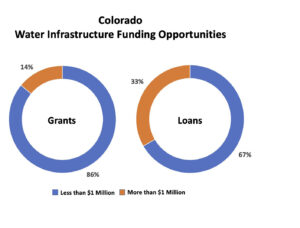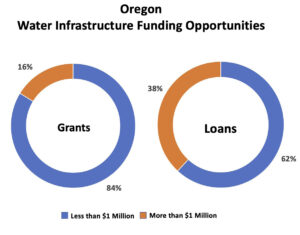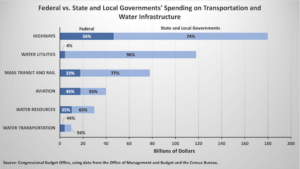Grants are vital tools for maintaining and upgrading water infrastructure, but they can be hard to locate and difficult to win. The decentralized nature of information on available grants means that municipal water providers often miss opportunities. To solve this problem, Tia Cavender and Fernando Gonzalez of Dig Deep Research set out to provide a comprehensive database of water infrastructure grants from government agencies. In this interview, Ms. Cavender and Mr. Gonzalez tell Municipal Water Leader about municipalities’ difficulties in finding and obtaining grants, how Dig Deep is providing a central repository of available grants, and how this information is enabling municipal water managers to maximize their dollars for maintaining and upgrading their infrastructure, even during the pandemic.
Municipal Water Leader: Please tell us about your backgrounds.
Tia Cavender: I am the CEO and founder of Dig Deep Research. We were founded in 2010 to help municipalities and agencies secure capital funding for water infrastructure projects. My background is in research, specifically for funding. I saw that more needed to be done to help engineers and municipalities get smart about the funding landscape and how to navigate it. I wanted them be able to take advantage of the best funding opportunities for their projects.
Fernando Gonzalez: I’ve been a researcher with Dig Deep for almost a year now. I’m a software engineer and database administrator from Brazil. I have worked in the software development industry for 20 years.

 Municipal Water Leader: Tell us about your new service.
Municipal Water Leader: Tell us about your new service.
Tia Cavender: Dig Deep’s Grant Pursuit Strategy (GPS) provides a roadmap for municipalities to identify which grants they should pursue and in which order. The GPS lays out which grants are the best fit for their projects and which ones they’ll be most competitive for and includes in-depth data analysis performed by our team. The result is a set of customized recommendations for pursuing external funds. This way, clients are pursuing exactly the right grants rather than chasing after funding that they might not be competitive enough to win.
Municipal Water Leader: What are the critical funding issues facing local water utility providers today?
Tia Cavender: One of the biggest challenges is a lack of funding. The US Water Alliance and the American Society of Civil Engineers estimate that the federal government needs to invest a total of $109 billion per year in water infrastructure over the next 20 years to close the water infrastructure gap. What’s available in federal and state grants can meet only a fraction of the need. This pits municipalities against one another, making the competition for scarce funds fierce. As a result, only a small proportion of grant applicants are actually successful.
Municipal Water Leader: How can local water utility providers best prepare to pursue water infrastructure funding?
Tia Cavender: First, they should use every opportunity to advocate for more funding at the local, state, and federal levels. For themselves, the best preparation is to plan ahead and start early. They should not wait until a project is shovel ready. They should decide which grants to pursue at least 2 years ahead of when they actually need the money. Also, they need to secure funding for the planning and design phases, not just construction.
Municipal Water Leader: How can providers balance the need to keep water rates low for customers with addressing the ever-increasing cost of repairing aging infrastructure?
Tia Cavender: Really, strategic grants planning is their best ally. It lets municipalities leverage their water revenues and fees as matching funds for external funding. It stretches taxpayer dollars and customer fees as far as possible. The alternative is waiting until they need the money and then having to fund 100 percent of the project with water user fees.
Municipal Water Leader: In what ways has the pandemic affected water infrastructure funding?
Tia Cavender: Communities are really struggling. Many have lost significant revenue. What we’re seeing across the United States are cuts of 17–21 percent in capital budgets. This means critical water infrastructure, wastewater, and storm water projects are being put on hold because there’s not enough money. These projects are for repairs and upgrades that are really needed and that affect people’s lives. Unfortunately, since more municipalities are pursuing the same small number of grants for more and more projects, the grants landscape is becoming even more competitive.
 Municipal Water Leader: How exactly do you help a municipality target funding sources?
Municipal Water Leader: How exactly do you help a municipality target funding sources?
Tia Cavender: Dig Deep’s GPS pinpoints exactly which grants to pursue so that municipalities aren’t spending a lot of time researching, identifying, and chasing after funding that might not pan out. The GPS helps communities plan ahead so that they know exactly which grant applications are coming up next year (and the year after) so that they can budget matching funds, staff time, and any other costs.
Also, our product helps municipalities leverage one funding source with another. For instance, if a local government has $1 million in matching funds and uses it to successfully pursue a state grant that provides another $3 million, it can make the local government more competitive for federal funds. It allows the community to optimize the funding potential for water infrastructure projects.
Municipal Water Leader: Do you mainly provide information about government-provided funds?
 Tia Cavender: Yes. The majority of what we help municipalities get is government funding, because it has the largest award amounts. We also help identify cases in which low-interest loans might be a better option for a municipality. For example, securing a low-interest loan at an annual percentage rate (APR) of 1–2.5 percent will provide significant savings above the rates available on the geobond market, which might be 3.5 percent APR. While it may be hard to understand, often a community can save more in interest payments than it would be able to win in grant funds.
Tia Cavender: Yes. The majority of what we help municipalities get is government funding, because it has the largest award amounts. We also help identify cases in which low-interest loans might be a better option for a municipality. For example, securing a low-interest loan at an annual percentage rate (APR) of 1–2.5 percent will provide significant savings above the rates available on the geobond market, which might be 3.5 percent APR. While it may be hard to understand, often a community can save more in interest payments than it would be able to win in grant funds.
Municipal Water Leader: Does Dig Deep focus on specific parts of the country, or are you national?
Tia Cavender: We have the expertise to help clients in any state, especially with federal funding. In 2020 and 2021, we have been specializing in Colorado, Hawaii, and Oregon, and we have particular expertise in all the 17 western states served by the Bureau of Reclamation. The GPS is applicable anywhere.
Municipal Water Leader: Can you quantify how many different sources are out there for potential clients in Colorado or Oregon?
Tia Cavender: Yes. Our proprietary database tracks capital grants for water infrastructure, and we can analyze them by state or many other factors. It’s astonishing how the number of state opportunities varies by state. For instance, in Colorado, there are 58 state and federal grants and 9 low-interest loan programs available for water infrastructure projects. Contrast that with Oregon, where 72 state and federal grants and 13 low-interest loans are available.
Based on aggregate analysis we have done, we can say that, on average, grants to support wastewater projects make up approximately 18 percent of total water infrastructure funding. That tells us that drinking water and storm water projects have more opportunities for grants than wastewater projects, which have more opportunities for loans.
Municipal Water Leader: Tell us about how you come up with this idea.
Tia Cavender: I came up with this idea back when I was an end user trying to find grants for brick-and-mortar projects. It was frustrating, because there is an immense gap in this information. There’s a place for federal grants; there are databases of foundations; but there is no central repository to search that is focused on capital infrastructure grants, not even for those in one state. In fact, many states don’t even have one place to look for all their own funding opportunities. You have to go to multiple websites and search through the information for every single department that might offer grants. I saw too many municipalities fail to get grants simply because they didn’t know that they should plan for all that research time.
In response, we designed our own grants database. It has one purpose and one purpose only: finding and tracking grants for capital water infrastructure projects. We started in 2010 and have kept improving it since then. With the addition of Fernando to our team in the past year, we are now able to make these data more accessible to communities in need and to help as many clients as possible.
Fernando Gonzalez: As someone who has made a career of finding and analyzing data, I can tell you it’s challenging to locate and understand the information about grants that is posted on government websites. So our team has done that work for you. In addition to publicly available data, we add our team’s personal knowledge and experience with funding sources to give personalized advice to clients on targeting their funding pursuits.
Municipal Water Leader: How does your database handle the unexpected, like a pandemic or stimulus funding?
Tia Cavender: It has been a lifesaver, actually. We can quickly access information on which funding sources are still available and which have been put on hiatus during the pandemic because the funds for those programs are tight. We also track legislation closely. For example, we were able to determine that the recently authorized stimulus funds that will be distributed soon to local government, counties, and state agencies can be used for water and wastewater infrastructure. Although the funds were created specifically for COVID‑19 relief, the federal government recognizes that many of communities put essential infrastructure projects on hold, so municipalities are able to use stimulus funds to pay for those.
This type of knowledge helps us advise our clients well. For example, it might be smarter for a community to earmark a portion of its stimulus funds for a water infrastructure project. Why? Because that makes for a great success story that the community can share with its federal delegation. Then it can point to how it invested its dollars to help meet a critical community need, rather than just putting the dollars into the general fund. That tells a much more compelling story and will contribute to educating our leaders about how much more federal investment is needed.
Waste of a Valuable Resource
• Annual U.S. water main breaks = 262,800
• Average = 1 break every 2 minutes
• 6 billion gallons of treated water lost every day
Source: Utah State University Buried Structure Laboratory study
Federal Agencies Most Committed to Water Related Capital Projects
• Bureau of Reclamation
• Federal Emergency Management Agency
• U.S. Department of Agriculture
Source: Dig Deep’s proprietary capital grants database, 2021.
Tia Cavender is the CEO of Dig Deep Research. She can be reached at tia@godigdeep.com.

Fernando Gonzalez is a database and IT manager for Dig Deep Research. He can be reached at fernando@godigdeep.com.
